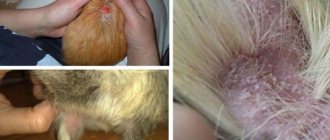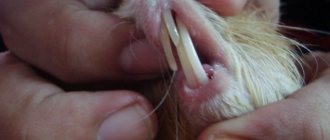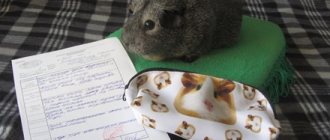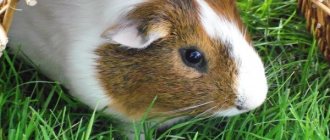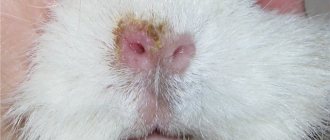- home
- Guinea pig
- Guinea pig health
02/14/2019 When purchasing a pet, you must make sure that it is in absolutely healthy condition. You need to find out everything from the seller, and also examine the pet yourself. Suitable and proper care is important for any animal; if it is not provided, the guinea pig may become ill or become infected with parasites. Ticks can cause serious harm. They are found in the fur, on or under the skin.
Group of ectoparasites
This type includes skin types of parasites. The most common are skin lice, fleas and lice. The first symptoms of a pet infection include redness and itching of the skin, as well as hair loss in areas where microorganisms accumulate. It is this type of parasite that causes diseases that cause exhaustion, purulent ulcers, and in advanced cases, death. Moreover, the latter scenario can occur not only due to the animal’s lack of appetite, but also due to less obvious signs such as general blood poisoning. The fact is that toxic substances enter the blood through abrasions and microcracks formed by scratching the affected areas by the animal itself.
Diagnostics
If you think your pet has become infected with mites, consult your veterinarian. He will make an accurate diagnosis using:
- Detailed examination of the animal;
- Questioning the owner about the habits and condition of the pet;
- Scraping for subcutaneous mites.
After the diagnosis is made, diagnostic treatment is prescribed, which is carried out strictly under the supervision of a doctor.
Important! If diagnostic therapy does not help, a full course of treatment is prescribed.
Fleas
Oddly enough, cat-type fleas are the most common in guinea pigs. These types of parasites can get onto an animal from anywhere, even from the owner’s skin. The symptoms of the disease are similar to the previous version: redness of the skin, itching, hair loss in the affected areas. Detecting fleas is not difficult: just comb your pet's fur thoroughly.
After thoroughly brushing your pet, it is important to check for insects between the teeth of the comb or comb. Fleas settle in the external environment (bedding, upholstered furniture, carpets); in animals they can only be detected during blood feeding. Guinea pigs become infected with these parasites from sick animals, most often dogs and cats.
The process of treating fleas itself is not so complicated, but the difficulty is that in addition to treating and monitoring the health of the sick animal, it is also necessary to monitor its environment, especially if there are small animals in the offspring. Treating the animal with topical shampoos and sprays is permissible; it is important that it contains pyrethritol. They also need to wash the cage and all accessible areas. In a couple of days of high-quality treatment of the animal, you can exterminate all pests along with their larvae.
Post-treatment tips
After the pet has recovered, it is necessary to take measures to help prevent the problem from reoccurring. To do this, the following conditions must be met:
- A rodent's diet should always be balanced. Try to minimize purchased food. From time to time you need to give your pet vitamins that will help strengthen the immune system;
- There should always be enough fresh water in the cage;
- If your pet is outdoors, it must be treated with special anti-parasite sprays;
- While bathing, you should also use products and shampoos that help get rid of parasites;
- If you just came from the street, do not forget to wash your hands and change clothes before you start interacting with your pet.
If your guinea pig is infected with subcutaneous mites, lack of treatment can lead to deterioration of the rodent's condition and even death. Therefore, when the first symptoms of the disease appear, begin treatment immediately, but only under the supervision of a veterinarian.
Ticks
There are two types of mites on guinea pigs - subcutaneous and scabies. Each has characteristic features both in manifestation and in treatment.
Scabies type of mite
The difference between this type of mites lies in the fact that they can cause severe itching of the animal’s skin. The danger for the animal lies in the fact that not only the blood will be infected, but the animal may also die due to stress. The main symptoms of subcutaneous mite infestation include the following:
- skin itching;
- severe hair loss;
- redness and dryness of the skin;
- high temperature, chills;
- refusal to eat completely or partially.
Primary lesions in guinea pigs include the head, back, sides and shoulders. But if you do not pay attention to the problem in time, they can spread throughout the animal’s body, causing even more discomfort. It’s even worse if a pregnant female is infected with parasites. In this case, there is a risk of miscarriages and complications during pregnancy. Ticks can spread to mumps both from humans and from contact with other animals. You can only determine whether there are mites on your pet's skin using a scraping procedure. It is worth noting that treatment should apply not only to the infected animal, but also to its entire environment.
Along with the injections, it is necessary to thoroughly rinse the cage with a solution containing lime sulphide or chlorine.
Fur type mite
The difference from the previous species is that it settles, as a rule, on the surface of the skin. Symptoms of infection with the disease in an animal are similar to previous species. Only peeling of the skin is also observed. Refusal of water and restlessness of the animal are typical symptoms of a tick. If the infection is severe, painful ulcers may appear on the skin, and fur will begin to fall out at an increased rate. It is worth noting that the fur type of tick is transmitted only through direct contact between a healthy and sick animal. The treatment method is similar to the previous analogue. The room where the sick animal is located should be treated with a special anti-tick compound.
Symptoms
The main sign of parasite infection is severe itching, pain and hair loss in areas of the skin. Sometimes the skin may begin to peel, the animal becomes irritated if touched and noticeably loses weight. If you touch the source of infection, the pig will feel discomfort and pain.
Therefore, the pet will begin to itch and try to gnaw its own body, which will cause even more harm and unnecessary problems in the form of large scratches and damage. The disease is best tolerated by healthy pigs; sick pets or young animals are much more difficult to tolerate infection.
Symptoms of the appearance of subcutaneous mites in a furry pet:
- severe shedding;
- the color of the wool becomes dull;
- dandruff forms;
- the animal scratches its skin bleeding;
- alopecia occurs;
- infected areas of the skin itch unbearably.
Lice
Despite the rarer occurrence of this type of parasite, they can occur even with good care of the pet. And, most dangerously, it can be transmitted to humans through contact with a sick animal. Lice cause the appearance of pediculosis, which is characterized by severe itching, obesity and increased temperature of the animal. Lice can be treated using fairly gentle methods: if the infestation is not so local, you can use specialized shampoos. Veterinarians recommend treating the animal with a 10-day course of ivarmectin just in case. The pig's cage must be washed with a solution containing chlorine. It is also necessary to shampoo all pets that have previously come into contact with the infected person.
Diseases dangerous to humans
Parasites that cause dangerous diseases for humans and live in the body of a guinea pig include:
- Strongyloidiasis,
- Giardiasis,
- Encephalitis.
Strongyloidiasis
The disease is caused by small roundworms that parasitize the small intestine. A person can become infected with worm larvae while cleaning a cage or processing an infected animal. The first and most important symptoms of the disease are nausea, severe abdominal pain, diarrhea, headache and dizziness. If you do not consult a doctor in a timely manner, anemia may develop. Cases of death have been recorded. Guinea pigs can carry larvae without showing symptoms of infection. This happens when the animal has the opportunity to walk in the summer and comes into contact with grass and soil outside.
Giardiasis
A person can become infected with giardiasis during cage cleaning, as well as through contact with an infected animal. The disease is caused by a small parasite that lives in the small intestine and gall bladder.
Symptoms of infection:
- Nausea,
- Stomach ache,
- Bloating, gas formation, constipation and diarrhea, replacing each other,
- Skin rashes
- Fatigue, increased drowsiness, loss of appetite, poor sleep and frequent dizziness.
lice eaters
This is another type of parasite that differs in that it can feed not only on particles of the animal’s skin, but also on its blood. Due to the small size of the parasites, it is quite difficult to detect them with the naked eye; you will have to use scraping. The first signs include hair loss of the animal, as well as itching. An animal's reduced appetite threatens death from exhaustion. The danger is that lice can get on the animal even with careful care, for example, through the owner’s clothes or toys from the store.
Comprehensive treatment measures include treating all animals that have previously been in contact with or are close to an infected individual, even if they do not show signs of infection.
Akaromectin, Bolfo and Bars spray can be used as medical assistants in the fight against lice eaters. Due to the fact that bathing is considered extremely stressful for pigs, it is best to opt for a spray, as it will cause them less discomfort. The animal does not resist the procedure and, if necessary, it must be repeated the prescribed number of times. This is usually done by a veterinarian. Lice remedies are also available in human pharmacies, but you need to choose those options that contain the substance permethrin. The largest number of breeders recommend choosing Advocate spray. Due to the content of fewer toxic substances, it is safer for the animal.
Lice eaters are localized in the croup and perineum; they parasitize at the roots of the hair, wrapping their limbs around the hair, and feed on blood, epidermal scales and secretions of the sebaceous glands. As a result, the affected hair falls out. Lice eaters are most active in winter, when the guinea pig's fur becomes thicker and longer, which is a favorable factor for the proliferation of parasites.
Lice feed on blood and are able to actively move around the animal’s body, causing itching. Parasites can be seen with the naked eye when parting the fur, mainly in the head area and around the ears.
Guinea pigs become infected with lice and lice through contact with sick relatives, through bedding and food.
Lice and lice cause itchy skin and severe anxiety in a sick animal, up to the appearance of seizures and convulsions. Fleas with intense infestation can cause inflammation of the skin - flea dermatitis. It is characterized by redness of the skin, baldness, and eczema.
Basal cell skin cancer
Basalioma is the most common, but at the same time the safest type of skin cancer. Death from basal cell carcinoma is possible only in very advanced cases or with aggressive forms (basosquamous) tumor. The favorable course of basal cell carcinoma is due to the fact that it almost never metastasizes (only 0.5% of cases).
Symptoms and signs
Most often, basal cell carcinoma occurs on the skin of the nose, a little less often on the face and much less often on other parts of the body.
The peak incidence occurs over the age of 40 years. The youngest patient diagnosed with basal cell carcinoma by histology was 39 years old.
What basal cell skin cancer looks like depends on the form:
- Nodular form (synonymous with nodular). The tumor is presented in the form of a nodule. It can be distinguished from other skin formations by an increased number of vessels on the surface, a waxy sheen and small gray-blue inclusions. All these signs are visible in the photo.
Nodular form of basalioma
In addition, on the surface of nodular basalioma there may be another characteristic sign - ulceration.
Nodular basal cell carcinoma with ulceration
- The superficial form of basal cell carcinoma in most cases is presented as an area of redness on the skin. Elements of peeling and the waxy sheen already mentioned above are also possible.
Superficial form of basalioma
- Scleroderma-like form of basalioma is very rare and often presents difficulties in diagnosis. It is characterized by a lighter and harder seal compared to the surrounding skin.
Scleroderma-like form of basalioma
- The pigmented form of basal cell carcinoma makes up a very small part of the total number of these tumors. It is distinguished by a large amount of pigment. In this regard, basal cell carcinoma is often mistaken for melanoma when examined without a dermatoscope.
Pigmented form of basalioma
- The ulcerative form of basalioma can reach very large sizes and in advanced cases is practically untreatable.
Ulcerative form of basalioma
Photos in the initial stage
Unfortunately, basal cell skin cancer is extremely difficult to diagnose in the early stages, i.e. when it is minimal in size. Here are some photos:
Basalioma of the skin of the nose, nodular form, size 5 mm
Basalioma, nodular form, 3 mm in diameter
Nodular basalioma of the temporal region, diameter 2 mm
Diagnosing basal cell carcinoma in the early stages, when the tumor is small, can present significant difficulties. Only a combination of a comprehensive examination of the entire skin, a thorough determination of the history of the existence of the formation and dermatoscopy will help in establishing the diagnosis of basal cell carcinoma at an early stage.
Basaliomas with high and low risk of recurrence (NCCN, 2018)
Area H: Facial mask (including eyelids, eyebrows, skin around eyes, nose, lips [skin and red border of lips], chin, lower jaw, skin/grooves in front and behind the auricle, temples, ears), genitals, palms and feet .
Area M: cheeks, forehead, scalp, neck and legs
Region L: trunk and limbs (excluding shins, palms, feet, nails and ankles)
Notes
- Localization, regardless of size, may be a sign of high risk
- Histological forms of low risk: nodular (nodular), superficial, keratotic, piloid, with differentiation towards skin appendages, Pincus fibroepithelioma
- Area H means high risk regardless of size
- Morphea-like, basosquamous (metatypical), sclerosing, mixed infiltrative, micronodular in any part of the tumor
To assign a tumor the status of “high risk of recurrence”, only one of the factors from the right or left column is sufficient.
Treatment of basal cell carcinoma
The main goal of treatment for basal cell carcinoma is complete removal of the tumor while maximally preserving the cosmetic properties and functions of those parts of the body where this tumor has developed.
As a rule, the best results are achieved by surgical methods. However, the desire to maintain functionality and cosmetic properties may lead to the choice of radiation therapy as the primary treatment modality.
Depending on the degree of risk of relapse (see above), the approach to treating basal cell carcinoma may vary.
In patients with superficial basal cell carcinoma and a low risk of recurrence, when surgery or radiation therapy is contraindicated or inappropriate, the following treatments may be used:
- 5-fluorouracil ointment;
- Imiquimod ointment (Aldara, Keravort);
- photodynamic therapy;
- cryodestruction.
Mohs micrographic surgery may be recommended for patients at high risk of recurrence.
Chemotherapy for basal cell carcinoma includes drugs that are inhibitors of the hedgehog signaling pathway – vismodegib (Erivedge) and sonidegib (Odomzo). These drugs can help in cases where surgical methods, like radiation therapy, are not applicable or contraindicated.
What you need to know about basal cell carcinoma?
- In the vast majority of cases, basal cell carcinoma does not pose a threat to life.
- If a histological examination of a distant formation results in basal cell carcinoma, there is nothing to worry about. It is important to make sure that the formation is completely - be sure to consult with an oncologist.
- If, after removal of a basal cell carcinoma, the histological examination contains the phrase “tumor cells in the resection margin” or something similar, further treatment in order to completely remove the tumor.
- strongly do not recommend removing basal cell carcinoma without histological examination, since even a very typical-looking formation may not be what it seems at first glance.
- Basalioma needs to be treated . Observation is a bad option for a diagnosis like this. Treatment of advanced forms (see photo of ulcerative form) is extremely difficult and expensive.
- If you have already had a basal cell carcinoma removed, you should regularly have your entire skin examined by an oncologist in order to possibly identify another such tumor.
- The likelihood of metastasis in the metatypical (basosquamous) histological type is higher than in other types.
Worms
Due to the fact that the main property of this group of parasites is to absorb nutrients from the animal’s blood, this can lead to exhaustion. Typically, guinea pigs are inhabited by tape and round parasites. Worm larvae of this type are dangerous not only for the animal, but also for the owner. With severe infection, you can see not only worm larvae in the stool, but also quite adult individuals with the naked eye. The animal is characterized by lethargic behavior, drowsiness and decreased appetite. If the infection is very strong, parasites crawling out of the anus can also be seen with the naked eye.
If the infection is not severe, you can give the animal a suspension of prazicide for kittens. The amount is calculated at the rate of 1 gram per 1 kg of animal weight. Dirofen paste has a good reputation among veterinarians. When treating an animal with medications, you need to treat the cage and accessories with a chlorine-containing solution.
Types of skin cancer
There are 3 types of common malignant skin tumors. They differ both in incidence (i.e., the chance of getting sick) and in the degree of danger to life - basal cell carcinoma, squamous cell carcinoma and melanoma.
Melanoma is one of the rare and dangerous skin tumors. It accounts for only 4% of the total number of malignant skin tumors, but is the cause of almost 80% of deaths in this localization. You can read more about melanoma here.
Sign up for the webinar “Carcinogens in cosmetics: truth, lies and... marketing”
Prevention
Since guinea pigs become infected from other pets, all pets should be treated periodically with insecticides .
Features of the American Teddy guinea pig breed.
The cleanliness of the cell plays an important role. Regular cleaning, changing bedding, disinfecting feeders and drinking bowls are important aspects of caring for a guinea pig. The pet's home is also washed with the addition of an insecticide. The smell of the product will repel fleas and ticks.
Sources
- https://homkin.ru/morskie-svinki/zdorovie-morskih-svinok/parazity-blohi-kleshhi-vlasoedy.html
- https://combat-dez.ru/kak-izbavitsia-ot-bloh-y-morskih-svinok/
- https://msvinkam.ru/bolezni/parazity-u-morskih-svinok.html
- https://homjakam.ru/morskaya-svinka/zdorove/parazity
- https://NaLugah.ru/zhivotnovodstvo/morskie-svinki/parazity-u-morskih-svinok-simptomy-i-lechenie.html
- https://klopkan.ru/blohi/vsyo-o-blohah/blohi-u-morskih-svinok/
- https://apest.ru/nasekomye/vlasoedy/vlasoedy-u-morskih-svinok/
- https://xvostus.com/morskaya-svinka/bolezni/blohi.html
[collapse]
Causes of exacerbation of demodicosis
- various types of dermatitis;
- weakened immune system;
- acne;
- skin infections;
- HIV;
- gastrointestinal diseases.
To treat the disease, you must consult a doctor. Self-medication in this case is evil. The doctor will conduct an appropriate study and prescribe adequate therapy.



